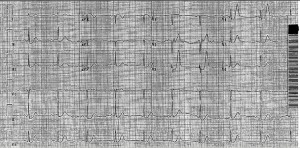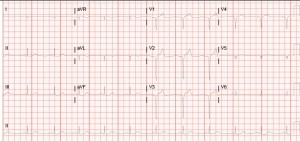Middle aged male transferred from an OSH, accepted by ENT for a mandible fracture.
The patient is incarcerated, and was involved in an “altercation” with other inmates. The incident occurred around 2PM; but he didn’t report any of his pain to the guards until 10PM. On arrival at the OSH he had multiple contusions to his face/head, lacerations over his hands, and obvious dental trauma. The patient was also complaining of chest pain – he stated that another inmate had slammed him in the chest with his knee. Despite his age, the patient has a history of previous MI in 2011, cathed at U of L with no stents placed. Takes a baby aspirin, no other meds and no other PMH.
At this point, the patient is about 10 hours out from the incident. Work-up at the OSH with the following: neg CT head and CXR. CT face with a mandible fracture. Labs notable for WBC 17.8, Hgb 14.3, platelet 373, normal coags, normal electrolytes, BUN/Cr 14.0/1.1. Total CK 213 (55-170 normal), troponin <0.012, CKMB 1.66 (0 – 3.38 normal), myoglobin 271.8 (0-121 normal). Tox screen negative. EKG is as follows:
His hand lacerations were repaired and he was started on Augmentin for a human bite. ENT accepted, and the patient was transferred to U of L, arriving about 6 AM. Dental was consulted on arrival and splinted his teeth. By 9 AM ENT had evaluated the patient and admitted him to the floor, planning for surgical intervention.
The patient was an ED floor hold, and around 2PM began complaining of worsening chest pain. ENT was paged and ordered an EKG and a set of cardiac enzymes, coming down to re-eval the patient. His EKG now looked like this:
Enzymes came back with CK total 5024, CKMB 303, and troponin 44.1. Cardiology was consulted and ordered a stat echo and started the patient on ACS protocol. The echo showed an EF of 30%, an akinetic mid/distal anferoseptum and an akinetic apex. Cards initially thought that this was consistent with stress cardiomyopathy in the setting of trauma, but couldn’t rule out cardiac ischemia due to direct cardiac trauma. They planned to treat medically and cath in the morning.
Throughout the evening, he developed worsening ST elevation in his lateral leads and his troponin continued to rise, up to 67.0 by midnight.
The on call cath attending at Jewish was consulted and by about 3AM the decision was made to transfer the patient to Jewish for a cath first thing in the morning.
Final result: 100% LAD occlusion, secondary to direct cardiac trauma.
Definitely rare injury, but one to keep in the back of your mind, especially as it can occur in previously healthy, relatively young patients. Of note, these can have delayed presentations, up to several days. Typically occur after MVA, but there are several cases reports occurring after crush injuries, being hit in the chest by a soccer/rugby ball, and my personal favorite, one listed as “struck in the chest by an umbrella tip.”
![Room9er ["Room Niner"]:](https://room9er.com/wp-content/uploads/2020/03/cropped-Screen-Shot-2020-03-08-at-3.16.16-PM.png)



What a cool case. The first ECG is a classic pattern of LAD occlusion, a STEMI equivalent. Does anyone know what it is called?
Also, do the repeat ECGs appear to be STEMI? Or benign early repol?
DeWinters T waves ?
reference : http://lifeinthefastlane.com/ecg-library/de-winters-t-waves/
Tall, prominent, symmetric T waves in the precordial leads
Upsloping ST segment depression >1mm at the J-point in the precordial leads
Absence of ST elevation in the precordial leads
ST segment elevation (0.5mm-1mm) in aVR
“Normal” STEMI morphology may precede or follow the deWinter pattern
Yes! deWinters. Dr Whiteside, a former resident had a case published in the EMRA journal. I will repost the STEMI equivalent article. For medicolegal and mortality bang for your buck, that article is critical for all emergency physicians.
The second question about BER. Those waves have a slight convexity to them. In addition, you MUST have tall R waves to diagnose benign early repol, as the benign part of it has to do with abnormal repolarization of a thick ventricle. early repol of a sick ventricle is what a STEMI is, due to potassium shifts across an ischemic membrane.
So that is NOT benign repol, which we could guess from the occlusion we diagnosed with deWinter’s waves.
Also AVL has TWI, one of the first signs of anterior MI. Whenever I see a flipped t-wave in AVL I worry. Seeing the hyper acute t-waves in V4 especially seals the deal.
Its capacity to promote lean muscle development, protect
muscle throughout fat loss, and improve energy makes it a useful tool for both men and women. Nonetheless, responsible use is
crucial to minimize unwanted effects and maximize outcomes.
For women starting a cutting cycle with Anavar,
it’s really helpful to start with a daily dosage of
5-10mg over 6-8 weeks. This strategy aims to achieve a lean and
sculpted physique by selling fats loss whereas preserving muscle.
To improve the effectiveness, combining
the dosage with a protein-rich diet and incorporating regular
cardio and power training is crucial.
Complete dissociation of anabolic and androgenic effects has not been achieved.
The actions of anabolic steroids are subsequently similar to these of male intercourse hormones with the potential for causing
critical disturbances of growth and sexual improvement if given to young youngsters.
Anabolic steroids suppress the gonadotropic capabilities of
the pituitary and will exert a direct impact upon the testes.
However, in follow, we now have discovered this to be inaccurate, with
SARMs demonstrating comparable levels of toxicity to anabolic steroids via our liver function and blood pressure
exams. Research additionally exhibits that SARMs can induce hepatic harm and cause cholesterol alterations in sure customers.
Following an eight-week cycle of Oxandrolone, vital outcomes can typically be seen.
This is the water that collects outdoors of the muscular tissues, inflicting a clean and puffy look.
Thus, with this fluid eliminated, trenbolone users can develop a extra toned and dry look.
Anavar, regardless of being a slicing agent, may be very efficient
at increasing muscular strength.
Winstrol is similar to Anavar in regard to positive
aspects, with Winstrol being slightly more practical. Nonetheless, Winstrol’s unwanted effects are much more extreme
compared, with testosterone getting shut down, liver damage,
and blood strain rising to high levels. Anavar is a versatile and gentle option, best for chopping and preserving lean muscle.
Anadrol, then again, is a potent mass builder fitted to bulking cycles.
As talked about within the part about buying Anavar, this drug is illegal and
not utilizing a prescription in most locations.
This contains the Usa, where oxandrolone is classified as a Schedule III drug as part of the Controlled Substances Act (CSA).
This implies that easy possession of Anavar pills could
result in up to a $250,000 nice and three years in jail.
However, it ought to be mentioned that any penalty this harsh
is very unlikely. There could be a number
of explanations for this, together with that oxandrolone
is not a well-liked PED amongst skilled athletes
due to the intense exercise pumps that it can trigger.
Finasteride (Propecia) is an FDA-approved medicine shown to be
efficient at blocking DHT levels within the physique and decreasing hair loss (19).
Nonetheless, studies show that roughly 52% of males report muscle loss when taking it (20).
Testicular atrophy is a common signal of decreased testosterone levels and impaired spermatogenesis.
We have seen Anavar negatively have an effect on fertility due to compromised HPT axis perform.
Nevertheless, sperm amount and quality typically enhance
post-cycle over a number of weeks or months.
Analysis has shown anabolic steroids increase sprint velocity in rats by up to 29% (14).
For many first-time customers, beginning with a short cycle is a good suggestion.
Anavar may help women gain muscle mass and energy with out inflicting the same degree
of androgenic side effects as other steroids. This signifies that
girls can experience important muscle progress with out creating masculine features similar to excessive physique hair, a
deepened voice, and an enlarged clitoris. Oxandrolone is banned by each major sports group as a result
of its exceptional performance-enhancing skills. Aggressive advantages stemming from Anavar embody increased energy, lean muscle gains, enhanced fats reduction and more stamina.
So that means that too high a DHT stage will cause prostate enlargement over time, and
also too low. To put this into perspective, massive doses of Anavar must be used for prostate issues
and for lengthy periods as it’s still a light compound,
although DHT derived. Was initially developed
in the Sixties and was proven to have numerous therapeutic purposes.
It was used to deal with those with loss of weight because of injury or illness.
In the 1980s, this manufacturing has slowed considerably from strain from the FDA, and
Anavar was taken off the cabinets in 1989. Worldwide markets then adopted suit, and Anavarlooks destined to
be one other steroid to disappear. Whereas Anavar is taken into account milder than many different steroids,
it nonetheless has potential unwanted effects, especially at greater doses.
On the plus side, Primobolan doesn’t come with the estrogenic unwanted effects so frequent with many different steroids, like water retention and gyno.
However there are other unwanted aspect effects to contemplate, together with androgenic ones like pimples and hair loss,
in addition to possible unfavorable modifications to levels of cholesterol.
Anavar is an oral anabolic cheap steroid Cycles
derived from dihydrotestosterone (DHT). It was originally developed
for medical functions, similar to promoting weight achieve in individuals
recovering from illness, surgical procedure, or trauma.
Nevertheless, its muscle-preserving and fat-reducing properties quickly
made it a favorite among bodybuilders and athletes.
Laws and laws will differ internationally when it comes to buying
and using anabolic steroids like Anavar. However in most international locations, it can only be purchased on the black market, and Anavar is generally priced larger than lots of different steroids.
In the Usa, it’s unlawful to purchase or use Anavar and
not utilizing a prescription from a well being care provider.
Your Anavar dosage will rely upon many issues, largely your private objectives and
what other steroids you plan to stack it with.
Newbies start with up to 50mg every day, and the most skilled customers can typically take as a lot as 100mg every day – but such
a high dose is not recommended for the novice. Anavar itself is derived from DHT (dihydrotestosterone), with some slight alterations to the structure of the hormone.